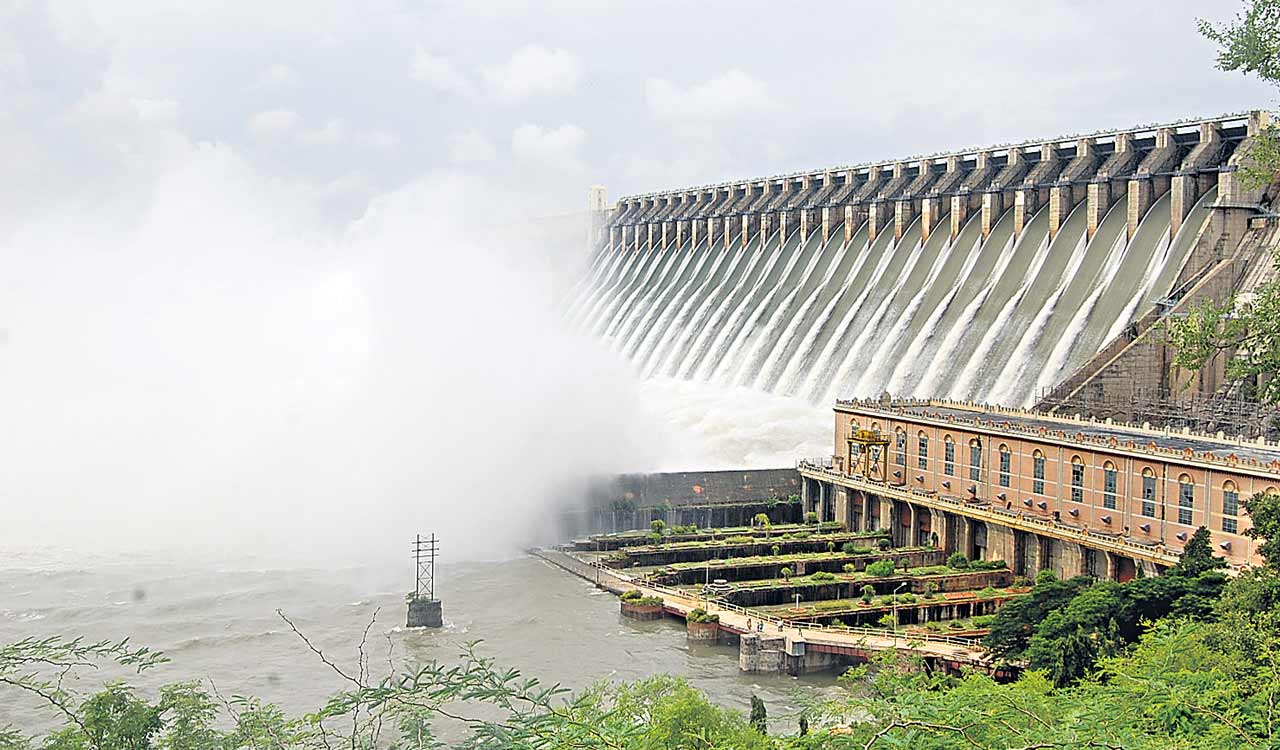About Nagarjuna Sagar Dam
- It is built between the Nalgonda district of Telangana and the Guntur district of Andhra Pradesh.
- It is built across the River Krishna.
- It is the largest and highest masonry dam in the world.
- The dam is 150m tall and 1.6 km long.
- The dam has a storage capacity of nearly 11,472 million cubic meters and an irrigation capacity of 9.81 lack acres of land.
- It derives its name from a nearby hillock and island called Nagarjunakonda, where an ancient Buddhist Guru had once lived.
- It is also one of the earliest projects built in post-independence India for irrigation and hydroelectricity generation.
- The construction of the dam commenced in 1956 and was completed by 1967.
- This dam supports the national grid with its electric power and provides irrigation water to five districts, including Khamman District, Nalgonda District, Guntur District, Prakasam District and Krishna District.
- As per the provisions of the Andhra Pradesh Reorganisation Act, 2014, Nagarjunasagar dam is controlled and supervised by Telangana.
Key Facts about Krishna River
- It is a river in south-central India.
- Origin: It rises in western Maharashtra state in the Western Ghats range near the town of Mahabaleshwar.
- In terms of water inflows and river basin, Krishna is the fourth biggest river after Ganga, Godavari, and Brahmaputra.
- Total Length: 1300 km
- Course: It passes through Maharashtra, Karnataka, Telangana and Andhra Pradesh and meets the Bay of Bengal at Hamasaladeevi in Andhra Pradesh, on the east coast.
- The Krishna River Basin extends over an area of about 258,948 sq. km, which is nearly 8 percent of the total geographical area of the country.
- Tributaries:
- The most important tributary is the Tungabhadra River. It has been formed by the Tunga River and the Bhadra River, which originate in the Western Ghats.
- Other tributaries include the Koyna River, Bhima River, Kundali River, Malaprabha River, Ghataprabha, Yerla River, Warana River, Dindi River, Musi River, and Dudhganga River.
Q1) What is the Andhra Pradesh Reorganisation Act, 2014?
The Andhra Pradesh Reorganisation Act, 2014 provides for bifurcation of Andhra Pradesh into the successor states of Andhra Pradesh and Telangana. Among other things, it addresses the representation of the states in Parliament, separate Legislative Assemblies and Legislative Councils for both states, role of the Governor, revenue distribution, distribution of cash and credit balances, management and development of water resources, and creation of separate cadres for administrative, police and forest services.
Source: In midnight operation before Telangana polls, Andhra Pradesh takes over half of dam
Last updated on November, 2025
→ Check out the latest UPSC Syllabus 2026 here.
→ Join Vajiram & Ravi’s Interview Guidance Programme for expert help to crack your final UPSC stage.
→ UPSC Mains Result 2025 is now out.
→ UPSC Notification 2026 is scheduled to be released on January 14, 2026.
→ UPSC Calendar 2026 is released on 15th May, 2025.
→ The UPSC Vacancy 2025 were released 1129, out of which 979 were for UPSC CSE and remaining 150 are for UPSC IFoS.
→ UPSC Prelims 2026 will be conducted on 24th May, 2026 & UPSC Mains 2026 will be conducted on 21st August 2026.
→ The UPSC Selection Process is of 3 stages-Prelims, Mains and Interview.
→ UPSC Result 2024 is released with latest UPSC Marksheet 2024. Check Now!
→ UPSC Prelims Result 2025 is out now for the CSE held on 25 May 2025.
→ UPSC Toppers List 2024 is released now. Shakti Dubey is UPSC AIR 1 2024 Topper.
→ UPSC Prelims Question Paper 2025 and Unofficial Prelims Answer Key 2025 are available now.
→ UPSC Mains Question Paper 2025 is out for Essay, GS 1, 2, 3 & GS 4.
→ UPSC Mains Indian Language Question Paper 2025 is now out.
→ UPSC Mains Optional Question Paper 2025 is now out.
→ Also check Best IAS Coaching in Delhi

















